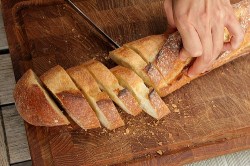Send your question to Umbra!
Q. Dear Umbra,
I’m moving this summer and we have tons of cutting boards! I might get rid of a few. Are any of the especially old ones (25+ years old) hazardous to my health? Especially the ones I’ve used to cut meat? And which is the more sustainable and healthy choice: plastic or wood?
Tina
Tucson, Ariz.

Photo by Dinner Series.
A. Dearest Tina,
The only thing worse than moving in the summer must be moving in the summer in the Southwest. Just the thought of lugging boxes and bags and ottomans (ottomani?) around in Arizona makes me sweat. I hope you are moving to a cooler place, so you’ll at least have relief on the other end.
But you didn’t ask me to analyze your life choices. Let’s talk about your cutting boards.
We should start by praising the loyal cutting board, in all its unheralded glory. This is one of our most durable household goods. It stands by us through thick chops and thin juliennes, never complaining, rarely breaking, always doing its job. Thank you, cutting board.
As a refresher, it is generally considered advisable to have at least two of these items on hand: One board should be designated for raw meat, seafood, and poultry, and the other board(s) for everything else. This helps avoid cross-contamination for purposes of health (keeping bacteria from sneaking into our produce, bread, and other non-fleshy items) and for purposes of hospitality (vegetarians and vegans will thank us).
In fact, this question of bacteria helps answer your question about plastic vs. wood. Plastic gained favor for a while because it is non-porous and dishwasher-safe, two qualities that made it seem like a healthier, cleaner choice. But it seems this was just another PR coup by the plastics industry. According to research, including a study at the UC-Davis Food Safety Laboratory, wood wins the bacteria battle. While bacteria such as salmonella and listeria are easy to clean off brand-new plastic boards, these boards become, say the researchers, “impossible to clean and disinfect manually” once damaged by knives. In other words, the sneaky little bacteria hide out in the cracks and crevices. Wood cutting boards provide a home for bacteria too, but only for a short time, and the little critters actually scoot down under the surface and die.
Because wood is magical! And if you buy a cutting board made from sustainably harvested sources, or even bamboo, it is definitely a greener choice than fossil-fuely old plastic. Of course, there are other options, like glass, marble, and ceramic — though purists will tell you they dull your knives (and not everyone can stand the noise they make). There’s even a disposable “cut and toss” paperboard version of the cutting board. Do not buy that one.
When is it time to retire cutting boards? According to the Food Safety and Inspection Service of the USDA, it is when they “become excessively worn or develop hard-to-clean grooves.” Of course, fans of wooden cutting boards also like to point out that they can be sanded or shaved to create a nice, new, smooth surface. You could keep yours through two or three more moves!
So Tina, I think your cutting boards are probably fine, and their advanced age poses little risk — the greater health risk is in the short-term after each use, which is why properly cleaning cutting boards is key (say hello to our old friend white vinegar!). If you do decide to winnow your collection, keep the wooden ones and part with the plastic. Best of luck with your move, and give my regards to Tucson.
Saguaroly,
Umbra



